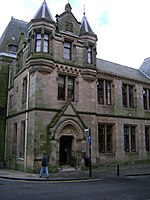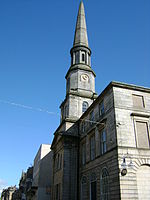Dunfermline Palace
15th-century establishments in ScotlandAnne of DenmarkBuildings and structures in DunfermlineCategory A listed buildings in FifeHistoric Environment Scotland properties ... and 8 more
Historic house museums in FifeHouses completed in the 15th centuryListed palaces in ScotlandPalaces in FifeRoyal residences in ScotlandRuins in FifeScheduled Ancient Monuments in FifeScottish parliamentary locations and buildings

Dunfermline Palace is a ruined former Scottish royal palace and important tourist attraction in Dunfermline, Fife, Scotland. It is currently, along with other buildings of the adjacent Dunfermline Abbey, under the care of Historic Environment Scotland as a scheduled monument.
Excerpt from the Wikipedia article Dunfermline Palace (License: CC BY-SA 3.0, Authors, Images).Dunfermline Palace
St Catherine's Wynd, Dunfermline Central Dunfermline
Geographical coordinates (GPS) Address Website External links Nearby Places Show on map
Geographical coordinates (GPS)
| Latitude | Longitude |
|---|---|
| N 56.0694 ° | E -3.4638 ° |
Address
Dunfermline Palace & Abbey (ruins)
St Catherine's Wynd
KY12 7NA Dunfermline, Central Dunfermline
Scotland, United Kingdom
Open on Google Maps










